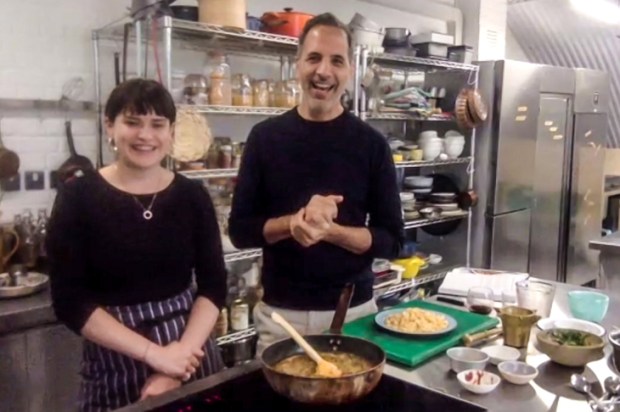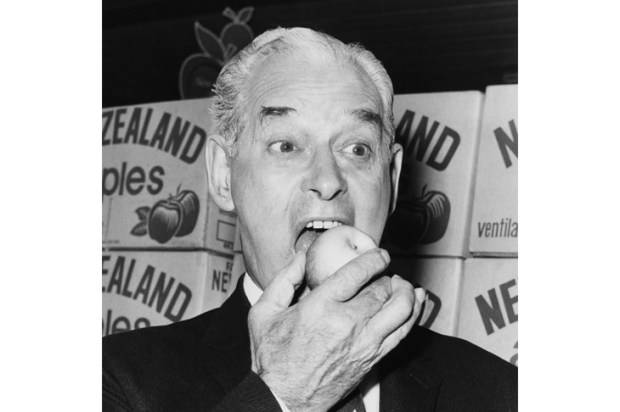Of the various little stories about the rather wonderful Joni Mitchell in her early years, my favourite concerns Leonard Cohen. In 1967, around the time the two Canadian songwriters were picking up speed in the music business, they met for the first time at the Newport Folk Festival. Mitchell, hair straight and blonde, was twenty-four. The pair became an instant item. Sort of.
As the randy old poet later told it, it too quickly became something of a cerebral relationship, give or take a racy night or two at the Chelsea Hotel before things took a more abstract turn. It was as if his new mini-skirted companion was less interested in a tumble in the sheets than ransacking his reading list. Wearily, one imagines, he obliged, dutifully steering her toward Camus, Lorca and his own battered copy of the I Ching. What japes. Shacking up with Joni Mitchell, Cohen later sighed, was like ‘living with Beethoven’.
For we fans, however, that slightly mixed assessment probably sounds exactly right musically speaking — especially if one is talking about the first four albums she crushed out in the time after the Cohen interlude and which are scheduled for reissue this month. In all their ragged glory, once again, that’s Songs to a Seagull, Clouds, Ladies of the Canyon and Blue.
You may disagree or have your own theories on whether the recorded life ever got better for Mitchell, who last performed in concert in our part of the world nearly forty years ago and quit the business for good in 2007, but it’s hard to dispute what an incredible breath of perfumed air those earliest efforts still are when judged against the other fifteen titles in her back-catalogue.
Of the various Joni Mitchell albums, my favourite is still Blue, whose fiftieth anniversary in June has been marked as the centrepiece of this latest burst of commercial activity.
I’m hardly alone. The work regularly appears atop of the various rankings of the ‘best’ albums of all time. According to the New York Times, it stands as one of the twenty-five ‘turning points and pinnacles’ in twentieth century popular music. In its most recent humungous album-ranking exercise, Rolling Stone ranked it third overall. The pretty biracial American boy who used to slavishly turn up at her shows in Minneapolis, Prince Rogers Nelson, probably would have sued for a Number One placing.
Why do so many of us get tangled up in Blue? For one thing, the ten songs, mostly composed or refined on the island of Crete, were pretty much the first time in the exclusively male rock club when a woman totally took charge of an entire album, writing, performing and producing the lot. There’s also the matter of the sheer originality of the weirdly coloured, sometimes jazzy music itself, swirling around Mitchell’s faraway voice. So many dark lights. The sophistication of the exercise tricks you into thinking the work is far longer than its relatively short running time of barely thirty-five minutes.
Mostly, though, it’s the artist’s own narrative method — ‘living on nerves and feelings,’ as Mitchell once described her etching process — as she navigates the dead ends and blind alleys of relationships, including the wreckage of one she had with Graham Nash, along with James Taylor, with whom she was having a soon-to-be-terminated fling.
On Blue, she sounds like the loneliest performer in the world; also, despite her still-tender twenty-eight years, she comes across as one of the most romantically insightful. ‘You’re my holy wine, You taste so bitter and so sweet, Oh, I could drink a case of you, darling, And I would still be on my feet.’ Here, as elsewhere, it’s like she has pulled ten threads that unravel her heart before proceeding to tie them together again in trembling knots, from up and down and still somehow.
Of the various explanations Joni Mitchell has since given about the broad theme at the jilted heart of her best work, my favourite is the one she gave to me during her last official visit to our part of the world.
Although her last proper tour of New Zealand and Australia took place in 1983, this was five or so years later when she made a quick promotional stop Down Under to hawk a new work, Chalk Mark in a Rainstorm, which I was less keen to discuss with the emotional scientist.
‘Romance is based on torture,’ she began, pausing to light the first of many cigarettes. ‘Romance increases with acts of cruelty and insecurity feeds it. In this culture, we’re so addicted to romance and a lot of what passes for it is just so much game playing.’
Why, just that past Valentine’s Day she had been reading a copy of Esquire magazine, which had a cover story on the end of sex. ‘It was such a provocative thing,’ Mitchell enthused. ‘What I remember it saying is this: If you want endless variety in a relationship, stay with one person; if you want endless repetition, see many people.’
She made it all sound like a craving, sort of like the cigarettes, a point Mitchell didn’t disagree with. ‘Romance addicts — and I used to be one — only ever enjoy the beginning of a relationship,’ Mitchell responded. ‘You get to run your best stories, your partner lets you know how delightful and entertaining you are, and your heart just flip-flops. But you know it’s deceitful. You can’t possibly keep it up.’
‘It’s beguiling and fearful, and those, to me, are the two elements that make up romance. Whereas love is something that comes from toughing it out. And for me, after seven years in a marriage situation, I prefer the ongoing art of keeping your heart open to a familiar person.’
By this, of course, she specifically meant the musician Larry Klein, whom she had married in 1982 and with whom, she felt, she had possibly reached the end of her romantic wanderlust. The couple separated in 1994. An amicable split it was, too, by most accounts, and I suppose it must have been as it never produced anything carrying the emotional voltage of Blue. But neither, really, has anything much else.
And now we have the original in front of us once more, all bitter and sweet and now spruced up. So sit down, light a candle and get ready to fall in love again. Beethoven’s back in the bedroom.
Got something to add? Join the discussion and comment below.
Get 10 issues for just $10
Subscribe to The Spectator Australia today for the next 10 magazine issues, plus full online access, for just $10.
You might disagree with half of it, but you’ll enjoy reading all of it. Try your first month for free, then just $2 a week for the remainder of your first year.















Comments
Don't miss out
Join the conversation with other Spectator Australia readers. Subscribe to leave a comment.
SUBSCRIBEAlready a subscriber? Log in